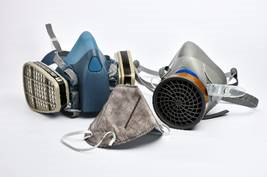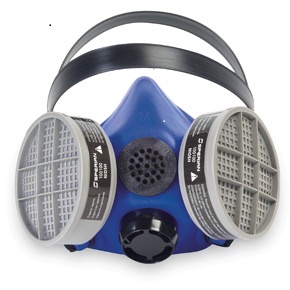Understanding respiratory protection options in Healthcare: The Overlooked Elastomeric
Posted on by
In the healthcare industry, the importance of respiratory protection is often overlooked. Choosing the correct respirator for the exposure level and work task is a critical component of a respiratory protection program. Most healthcare workers are aware of the N95 respirator but may not be aware that the re-formable, reusable elastomeric respirators are a viable option for respiratory protection. (Peterson et al., 2015). Elastomeric respirators with N95 cartridges have been used during aerosol transmissible disease outbreak emergencies like SARS as a reusable N95 respirator option. (CDC-NIOSH January 20, 2012) They are a cost-efficient and sustainable alternative when the demand for disposable respirators is excessive. This blog aims to educate healthcare workers and administrators about elastomeric respirators. A summary of various types of respiratory protection for the healthcare setting, including elastomeric respirators, is included below. It is important to understand the most suitable respiratory protection option given the potential hazards of a situation.

Surgical Masks
Surgical masks are not respirators. They are disposable coverings designed to be loose-fitting over the user’s nose and mouth. These loose-fitting masks leave gaps between the mask and the wearer’s face through which harmful particles may pass. Since the Food and Drug Administration (FDA) does not address the fit function of masks and surgical masks are not NIOSH approved, the mask may not be used in situations covered by Occupational Safety and Health Administration (OSHA) within areas requiring the use of respiratory protection. Therefore surgical masks should never be used for protection against infectious aerosolized particles.
N95 Respirator and Surgical N95

Both the N95 respirator and the surgical N95 are filtering facepiece respirators (FFRs) with an assigned protection factor (APF) of 10. The level of protection is the major difference between surgical masks and FFRs; the APF of 10 means the N95 reduces the aerosol concentration to 1/10 of that in the room and this equates to blocking 90% of airborne particles from being inhaled. (CDC-NIOSH, May 23, 2017). Both types of N95 respirators protect the user from aerosolized particles, whereas the surgical mask does not.
Standard N95: NIOSH-approved device (not FDA cleared). Used to reduce inhalation of aerosolized particles. Fit testing is required.
Surgical N95: NIOSH-approved and cleared by the FDA as a medical device. Meaning the protection characteristics are the same as the standard N95, except that the surgical N95 protects the sterile field, while protecting the worker with spray and splash resistance as well as flame resistance. Fit testing is required.
The most common type of N95 respirator is disposable and not designed for extended use. However, healthcare workers may be directed to re-wear these respirators, with specific directions, during emergency shortages (CDC-NIOSH March 13, 2014). For a true reusable respirator, an elastomeric or powered air purifying respirator should be considered.
Elastomeric Respirator

An elastomeric respirator is a reusable device with exchangeable cartridge filters that also has an APF of 10. The facepiece is made of synthetic or rubber materials that form a seal against the user’s face, with properties that allow the original shape to be repeatedly reestablished if it is temporarily deformed. As the facepiece of the elastomeric respirator should form a tight seal against the user’s face, just like the disposable FFRs, fit testing is still required. A particular challenge and potential benefit of an elastomeric air purifying respirator (APR) is that it may be disinfected through a process using a bleach water mixture. The ideal way to disinfect these respirators is with bleach and water. However, the use of bleach and water use is not practical between patients. Therefore, alcohol may be used for disinfection by wiping the exterior surface. The attached filtering cartridge(s) is replaceable and can be easily changed (Bessesen et al., 2015). This makes the device valuable during times of high demand, such as during a pandemic. Unfortunately procedures for disinfection and decontamination within healthcare environments are not routine and must be established for the environment where elastomerics may be used. Further complicating its common use, many healthcare workers have never heard of the elastomeric respirator, which indicates that there is a great need for education about the option of this type of respiratory protection. Although OSHA considers the protective factor for the elastomeric FFR to be the same as the disposable standard N95 FFR, some health facilities use the elastomeric exclusively due to employee’s perceptions of better fit. The elastomeric FFR may potentially cost less over time and may not create as much hospital waste as the N95 FFR due to the extended wear time. The elastomeric respirator offers a viable protection option that hospital administrators and healthcare workers may consider when updating respiratory protection programs.
Powered Air Purifying Respirator (PAPR)

The Powered Air Purifying Respirator (PAPR) is an additional option for consideration. These battery-powered respirators may have an OSHA APF of 25 for the loose-fitting PAPR facepiece, an APF of 50 for the tight-fitting half-mask PAPR, and an APF of 1000 for the full facepiece PAPR. The PAPR provides superior respiratory protection compared to FFRs and elastomeric respirators, but healthcare workers complaints have been associated with the physiologic and ergonomic impact of wearing the apparatus including restricting peripheral vision. Loose-fitting PAPRs may be used when fit testing fails or when facial hair is present. PAPRs also have higher initial costs and additional proprietary ancillary supplies (batteries, hoods) adding additional logistical challenges for product management.
What are your thoughts?
None of these devices provide absolute respiratory protection (NAS, 2006). Correct donning and doffing procedures are important to achieve suitable protection. Understanding the available types of respiratory protective devices and their correct use are important to the promotion of healthy working environments. Elastomeric respirator use is a practical option that may be considered for respiratory protection within healthcare institutions. Further discussion is needed to evaluate the pros and cons of instituting a strategy for the use of this type of respirator within the healthcare industry. Please use the comment section below to add your thoughts to the conversation. Does your institution have a strategy for adoption of elastomeric use? Do you see benefits? Drawbacks? Should elastomerics be considered as part of an overall strategy during a pandemic when demand for N95’s exceeds available supply? Should elastomerics be part of hospital and public health stockpiles?
Michael Bach PhD, RN, is an American Association of Colleges of Nursing (AACN) Fellow with NIOSH
Mention of any company, product, or service is for informational purposes only and does not constitute endorsement by the National Institute for Occupational Safety and Health (NIOSH), the Centers for Disease Control and Prevention (CDC), or the U.S. Department of Health and Human Services (HHS), or imply that any company or its products or services are preferred over any other.
References
Bessesen, M. T., Adams, J. C., Radonovich, L., & Anderson, J. (2015). Disinfection of reusable elastomeric respirators by health care workers: A feasibility study and development of standard operating procedures. American journal of infection control, 43(6), 629-634.
CDC-NIOSH January 20, 2012. Retrieved from: https://www.cdc.gov/niosh/npptl/topics/respirators /factsheets/respsars.html
CDC-NIOSH March 13, 2014. Retrieved from: https://www.cdc.gov/niosh/topics/hcwcontrols/ recommendedguidanceextuse.html
CDC-NIOSH May 23, 2017. Retrieved from https://www.cdc.gov/niosh/npptl/topics/respirators/disp _part/n95list1.html
National Academy of Sciences (NAS), (2006). Reusability of facemasks during an influenza pandemic: Facing the flu. Committee on the development of reusable facemasks for use during influenza pandemic. National Academies Press: Washington, DC.
Peterson, K., Novak, D., Stradtman, L., Wilson, D., & Couzens, L. (2015). Hospital respiratory protection practices in 6 US states: A public health evaluation study. American journal of infection control, 43(1), 63-71.
Additional Resources
- https://www.cdc.gov/niosh/docs/2015-117/default.html
- https://www.cdc.gov/niosh/docs/wp-solutions/2016-109/default.html
- https://blogs.cdc.gov/niosh-science-blog/2009/10/14/n95/
- https://www.cdc.gov/niosh/npptl/topics/respirators/disp_part/RespSource.html
The Centers for Disease Control and Prevention is addressing questions related to the Coronavirus Disease 2019 through CDC-INFO and on their webpage. As such, this blog has been closed to comments. Please visit https://www.cdc.gov/coronavirus/2019-ncov/index.html. You can find the most up-to-date information on the outbreak and get the latest answers to frequently asked questions. If you have specific inquiries, please contact CDC-INFO at https://wwwn.cdc.gov/dcs/contactus/form or by calling 800-232-4636. If you have questions about PPE that are not related to Coronavirus Disease 2019, please contact us at PPEConcerns@cdc.gov.
Posted on by

